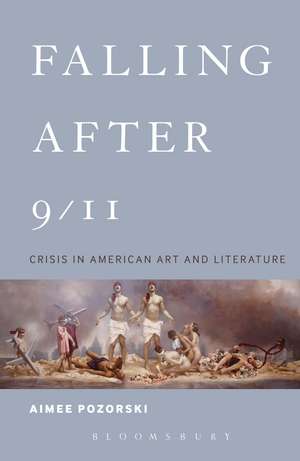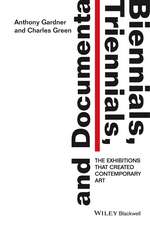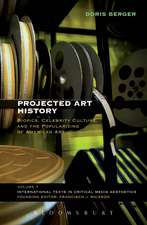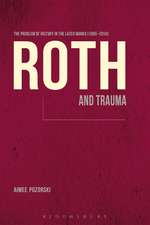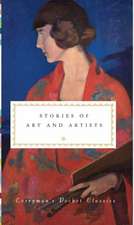Falling After 9/11: Crisis in American Art and Literature
Autor Dr. Aimee Pozorskien Limba Engleză Paperback – 20 apr 2016
| Toate formatele și edițiile | Preț | Express |
|---|---|---|
| Paperback (1) | 254.37 lei 6-8 săpt. | |
| Bloomsbury Publishing – 20 apr 2016 | 254.37 lei 6-8 săpt. | |
| Hardback (1) | 770.68 lei 6-8 săpt. | |
| Bloomsbury Publishing – 17 dec 2014 | 770.68 lei 6-8 săpt. |
Preț: 254.37 lei
Preț vechi: 293.78 lei
-13% Nou
Puncte Express: 382
Preț estimativ în valută:
48.69€ • 52.90$ • 40.93£
48.69€ • 52.90$ • 40.93£
Carte tipărită la comandă
Livrare economică 21 aprilie-05 mai
Preluare comenzi: 021 569.72.76
Specificații
ISBN-13: 9781501319631
ISBN-10: 1501319639
Pagini: 176
Ilustrații: 1 bw illus
Dimensiuni: 140 x 216 x 10 mm
Greutate: 0.21 kg
Ediția:NIPPOD
Editura: Bloomsbury Publishing
Colecția Bloomsbury Academic
Locul publicării:New York, United States
ISBN-10: 1501319639
Pagini: 176
Ilustrații: 1 bw illus
Dimensiuni: 140 x 216 x 10 mm
Greutate: 0.21 kg
Ediția:NIPPOD
Editura: Bloomsbury Publishing
Colecția Bloomsbury Academic
Locul publicării:New York, United States
Caracteristici
Closely reads a variety of genres of poetry, novels, journalism, mural art, and photography
Notă biografică
Aimee Pozorski is Professor of English at Central Connecticut State University, USA, where she teaches contemporary literature and trauma theory. She is the current President of The Philip Roth Society.
Cuprins
Preface Acknowledgements Introduction Falling After 9/11: Crisis in American Art and LiteratureChapter 1 Gravity, Gravitas, Grave: How to Refer to FallingChapter 2 Beyond the Literal: The Falling Man and Moral FailingChapter 3 Journalism's Falling Man: Documentation and Truth-TellingChapter 4 Don DeLillo's Performance Art: Failure Bears Witness to FallingChapter 5 The Poetics of Falling: The Lyrical Laments of Kennedy and SeussChapter 6 Extremely Loud and Incredibly Close: Historical Reverberation and Scientific Invention in Jonathan Safran Foer's 9/11 IconotextEpilogue Cycle of Terror and Tragedy: Parrish's 9/11 Mural Revisited Works Cited Index
Recenzii
In this tightly focused study, Aimee Pozorski draws out the links between trauma, aesthetics and memory, and tracks how the censored image of the falling man continues to haunt the American imagination.
Aimee Pozorski takes post-9/11 literary scholarship to the next level. This erudite and thoughtful book addresses the crisis in literary and artistic representation in the wake of the 2001 terrorist attacks. Pozorski moves beyond the notion of language, literature and art as delimiting the apprehension of the traumatic event to make the case that we are simply unable to read signs within our culture. Drawing together key theoretical ideas and critical analyses to offer a series of shrewd textual readings, Pozorski offers fresh and inventive insights. Falling After 9/11 is a substantial scholarly achievement.
Pozorski's attentive investigation of the 9/11 falling man in art and literature reinvigorates our thinking about violence, trauma, and aesthetics. Challenging the conventional wisdom about trauma's resistance to representation, Pozorski daringly asserts that the inescapably literal presence of the falling man produces the opposite effect: an overwhelming abundance of representational possibility.
In these illuminating and diverse analyses, Aimee Pozorski breaks new ground for trauma studies and its place in the twenty-first century. Richly argued and lyrical in its readings of the horrific beauty of the figure of the falling man, her book shows how trauma in the post 9/11 era is uniquely characterized by the excessive potential for reference rather than by inherent limitations to reference. Falling After 9/11 offers a telling critique of how the falling man can become, through the power of language and narrative, a figure who falls up, as it were, into alternative futures in which coming to terms with the terror of real events becomes a genuine possibility.
A timely book about the phenomenon of collective mourning in the 21st century, Falling After 9/11 illuminates the complex dynamic between the national clamor to 'never forget' and the ubiquitous mistrust of the artistic forms to which we attempt to commit that memory. Pozorski offers a lucid and engaging account of a moment of crisis in American literature that deftly speaks to fundamental theoretical questions about how we read the world around us.
Falling After 9/11 does an excellent job of corralling various literary representations of the falling man, and of thinking through what these representations might imply about the broader state of US art. . [Pozorski's] decision to focus on the figure of the falling man is an ingenious one, and it is her sustained examination of this recurring trope that gives the book its momentum. . Pozorski's readings are nuanced and incisive, and she makes a persuasive argument on the moral and artistic complexities associated with post-9/11 art. Her account of the recurring presence of the falling man in a diverse range of texts will strongly inform future studies . In emphatically answering the provocative questions posed by a range of post-9/11 artworks-including Mouly and Spiegelman's iconic New Yorker cover art-Pozorksi reveals the many ways in which trauma can be meaningfully represented, and in doing so expands our understanding of the tragedy of 9/11 itself.
Pozorski examines the figure of the falling man in 9/11 literature and the arts, and its representation within the theoretical framework of trauma . Pozorski is at her best when she shows how, as she writes in the introduction, 'critics in the contemporary art and literary worlds demand representations of 9/11 fraught with jarring images.' The author successfully highlights the contradictory behaviors of critics and the general public. On the one hand, they demand that artists address the big questions and problems of the times. On the other hand, they have a tendency to dismiss such works, often judging them inappropriate, inadequate, untimely, disrespectful, opportunist, too clean, or too violent. The epilogue-a detailed analysis of Parrish's mural painting The Cycle of Terror and Tragedy (depicted on the book's cover)-is absolutely brilliant in providing new ways of thinking about and interpreting the representations of 9/11 in art and literature. Summing Up: Highly recommended. Graduate students, researchers, faculty.
Aimee Pozorski takes post-9/11 literary scholarship to the next level. This erudite and thoughtful book addresses the crisis in literary and artistic representation in the wake of the 2001 terrorist attacks. Pozorski moves beyond the notion of language, literature and art as delimiting the apprehension of the traumatic event to make the case that we are simply unable to read signs within our culture. Drawing together key theoretical ideas and critical analyses to offer a series of shrewd textual readings, Pozorski offers fresh and inventive insights. Falling After 9/11 is a substantial scholarly achievement.
Pozorski's attentive investigation of the 9/11 falling man in art and literature reinvigorates our thinking about violence, trauma, and aesthetics. Challenging the conventional wisdom about trauma's resistance to representation, Pozorski daringly asserts that the inescapably literal presence of the falling man produces the opposite effect: an overwhelming abundance of representational possibility.
In these illuminating and diverse analyses, Aimee Pozorski breaks new ground for trauma studies and its place in the twenty-first century. Richly argued and lyrical in its readings of the horrific beauty of the figure of the falling man, her book shows how trauma in the post 9/11 era is uniquely characterized by the excessive potential for reference rather than by inherent limitations to reference. Falling After 9/11 offers a telling critique of how the falling man can become, through the power of language and narrative, a figure who falls up, as it were, into alternative futures in which coming to terms with the terror of real events becomes a genuine possibility.
A timely book about the phenomenon of collective mourning in the 21st century, Falling After 9/11 illuminates the complex dynamic between the national clamor to 'never forget' and the ubiquitous mistrust of the artistic forms to which we attempt to commit that memory. Pozorski offers a lucid and engaging account of a moment of crisis in American literature that deftly speaks to fundamental theoretical questions about how we read the world around us.
Falling After 9/11 does an excellent job of corralling various literary representations of the falling man, and of thinking through what these representations might imply about the broader state of US art. . [Pozorski's] decision to focus on the figure of the falling man is an ingenious one, and it is her sustained examination of this recurring trope that gives the book its momentum. . Pozorski's readings are nuanced and incisive, and she makes a persuasive argument on the moral and artistic complexities associated with post-9/11 art. Her account of the recurring presence of the falling man in a diverse range of texts will strongly inform future studies . In emphatically answering the provocative questions posed by a range of post-9/11 artworks-including Mouly and Spiegelman's iconic New Yorker cover art-Pozorksi reveals the many ways in which trauma can be meaningfully represented, and in doing so expands our understanding of the tragedy of 9/11 itself.
Pozorski examines the figure of the falling man in 9/11 literature and the arts, and its representation within the theoretical framework of trauma . Pozorski is at her best when she shows how, as she writes in the introduction, 'critics in the contemporary art and literary worlds demand representations of 9/11 fraught with jarring images.' The author successfully highlights the contradictory behaviors of critics and the general public. On the one hand, they demand that artists address the big questions and problems of the times. On the other hand, they have a tendency to dismiss such works, often judging them inappropriate, inadequate, untimely, disrespectful, opportunist, too clean, or too violent. The epilogue-a detailed analysis of Parrish's mural painting The Cycle of Terror and Tragedy (depicted on the book's cover)-is absolutely brilliant in providing new ways of thinking about and interpreting the representations of 9/11 in art and literature. Summing Up: Highly recommended. Graduate students, researchers, faculty.
